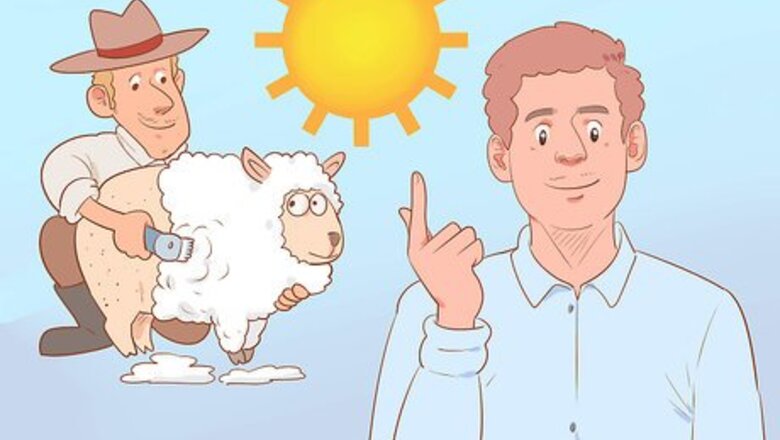
views
Preparation and Planning

Understand why the sheep needs to be sheared. Shearing is done for two main reasons: to collect sheep's wool for sale, but more importantly to relieve the sheep of heavy wool which may cause them to overheat in summer. In some parts of the world, sheep shearing is even considered a sport! If the sheep are not sheared, they will become uncomfortable and possibly unhealthy, due to the dirt that can become matted up in their wool. Therefore, even if you do not plan on selling the wool for profit, your sheep will still need to be sheared at least once a year. Due to its warmth and the ease with which it can be spun into yarn, wool from certain breeds of sheep is a valuable commodity. These animals are often raised differently and fed a special mineral-rich diet to improve the quality of their wool. A single sheep can produce 8 to 10 pounds of wool.
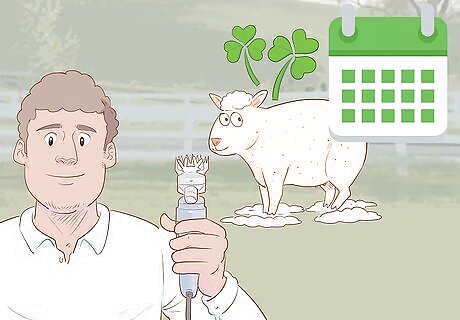
Choose the right time of year. Most sheep only need to be sheared once a year, although some breeds with faster-growing wool will need to be sheared twice. The best time of the year to shear your sheep is in early spring before the lambing season starts and the hot summer weather sets in. Shearing ewes before the lambing season is a good idea for many reasons. It will help to keep them cleaner while giving birth and make it easier for the lambs to find their mother's teats for feeding. If the animals are kept in a barn during lambing season, the sheared sheep will also take up less space. Another reason shearing before the lambing season is a good idea is that sheared ewes will often eat more grass to produce more body heat. This provides them with the extra nutrition they need before giving birth. Try to shear the sheep about a month before they give birth to the lambs. This will give them time to get over the stress of shearing. If you own a breed of sheep with fast-growing wool (such as Cotswolds, Icelandics, and Lincolns) aim to do the shearing in late summer or early autumn. Sheep will need at least six weeks to grow their wool before the winter weather sets in.
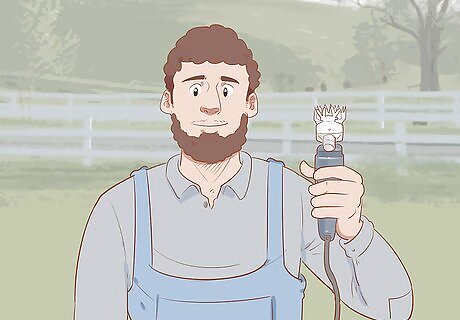
Consider calling an experienced sheep shearer. Although it may not seem like it, shearing a sheep is very hard work. It requires confidence, skill, and strength. Therefore, it might be a good idea to call in a professional shearer to perform (or at least help out with) the shearing. An inexperienced shearer can cause injury to the sheep or himself. It can also stress the animal, therefore affecting its health. In addition, an unskillfully sheared sheep can cause damage to the wool, thereby making it less valuable for selling. In certain areas, professional sheep shearers can be booked out months in advance, so it's a good idea to call well ahead of shearing time. Other options include bringing the sheep from several smaller farms to a central location to be sheared. Here a hired shearing crew can shear all the sheep and process the wool simultaneously. If you're adamant about shearing the sheep yourself, you can learn the proper skills by attending a sheep shearing school. Many sheep-farming states hold annual shearing classes that are open for any shepherds to attend.

Gather the right equipment. It's very important to have good quality shearing equipment. This will make the whole process much easier and is safer for both the shearer and the sheep. These days, electric cutters are used almost exclusively. Electric shears have three main parts - the handpiece, the comb, and the cutters. Look for shears with a higher number of teeth on the comb, as these tend to cut closer to the skin. You can expect to pay $250 to $500 for good-quality electric shears. It's important to ensure that your cutters are still sharp before you begin shearing. Dull cutters will be more difficult to use and could be dangerous for both you and the sheep. Luckily, it is very easy to just replace the cutters on your shears. New cutters will cost between $10 and $15. In years gone by (and in places with limited access to electricity) shearing was done using hand shears. This method of shearing is much more time-consuming and leaves more wool on the sheep.

Herd the sheep into a pen. Before shearing, the sheep should be rounded up and gathered into a pen. If possible, separate the sheep into groups, keeping any lambs, yearlings, ewes and rams separate from each other. You could also separate the sheep according to breed or grade. Don't allow the sheep to get wet. Make sure that the sheep are not exposed to rain before shearing, as wet sheep cannot be sheared. This is because the shearer or the sheep could receive an electric shock (from the shears) and wet wool cannot be rolled up and sold. Fast the sheep for a day before shearing. Sheep should not be given any food for the day before shearing. This will reduce the amount of waste they produce and help to keep the shearing floor clean. It will also minimize their discomfort when rolled on their backs for shearing.
Shearing the Sheep
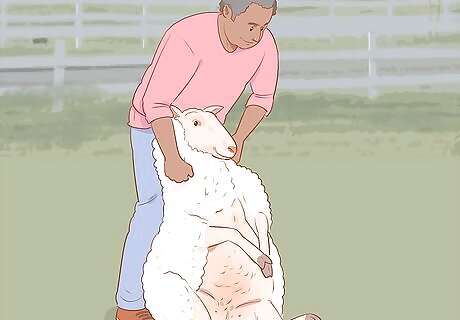
Get the sheep in position. The first step in shearing a sheep is to get it in the correct position. There are five main positions you will need to use throughout the shearing process. The first involves gently tipping the sheep over onto her back, then propping her shoulders between your knees for support. Her belly should be exposed and her four legs should be in the air. Keep in mind that the more comfortable your sheep is during shearing, the less she will struggle - making your job easier as a result.
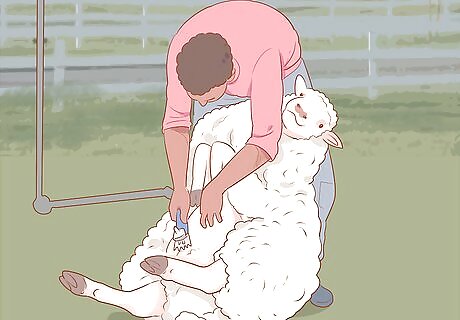
Start shearing the belly. The wool on the sheep's belly is normally the dirtiest and is not valuable for selling. This is why it is a good place to start. Using long, confident blows (this is the correct term for shearing strokes), shear the wool from the top of the brisket (breast bone) all the way down to the open flank area. Make your first blow on the right-hand side, your second on the left, then shear off the wool in between. Make sure the first and second bellies are set wide enough apart. This will make the rest of your job easier down the line.
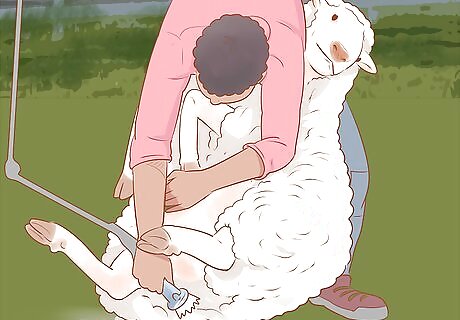
Shear the inside of the hind legs and crotch. The next step is to the wool from the inside of the hind legs and the crotch. To do this: Lean further forward (still holding the sheep firmly between the knees) and bring the shears up along the inside of the right leg. Then bring the shears across to remove the wool along the crotch. This blow may need to be repeated to ensure all the wool is removed. Now run the shears down the inside of the right leg. The most important thing to be aware of here is the ewe's teats. It's advisable to cover the teats with your left (or non-dominant) hand to prevent yourself from accidentally shaving them off.
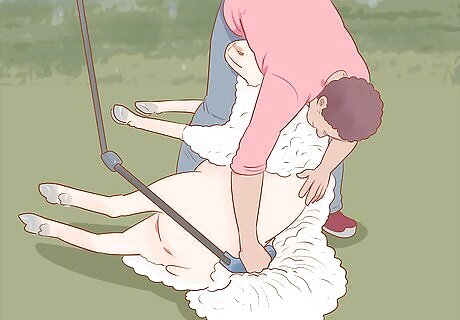
Change position and shear the left hind leg and tail. Turn approximately 90 degrees so that your right knee is in front of the brisket and the sheep's right foreleg is in between your legs and her left side is exposed. First shear the wool from the sheep's left hind leg, starting at the toe and working your way up towards the hind quarters, finishing on the near side of the backbone. Shift your right leg a few inches backward to gain better access to the sheep's tail. Position the comb of the shears so it will enter the wool at the top of the tail. Make a blow from the top of the tail upwards along the backbone. Repeat once or twice to clear all the wool from the tail. Since you have easy access to the sheep's head in this position, you can take this opportunity to shear the topknot of fleece from the sheep's head, if necessary.

Shear the chest, neck, and chin. Before you continue, you will need to move into the third position. To get in position: Place your right foot in between the sheep's hind legs and your left foot at the base of her spine, holding her body firmly between your knees. Use your left hand to grab the sheep below the chin and stretch her head backward. Bring your clippers from the brisket towards the neck, ending your blow just below her chin. This is one of the most satisfying parts of the process, as it feels like you are "unzipping" her fleece. Continue to make long parallel blows along the left side of her neck, ending first beneath her eye and then beneath her ear. Use your left hand to hold her ear back so you don't nick it.
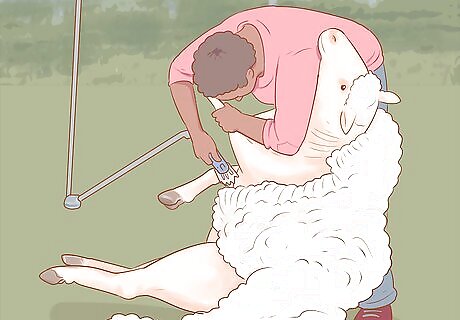
Shear the left shoulder. Shift your weight and maneuver the sheep slightly, so you have better access to her left shoulder. As the skin on the shoulders can be quite wrinkled, use your left hand to pull the skin taut. This will make your blows a lot smoother and help you to avoid nicking or cutting the sheep. Starting from her left knee, shear upwards towards her left shoulder, using one or two blows to clear the wool. You should also use this as an opportunity to clear the wool from the inside of her left foreleg.

Change position and start shearing along the sheep's back. Move into the fourth position by sliding the sheep down along your shin until she's lying on her right side. Keep your right foot between her hind legs and your left foot under her shoulder. Now it's time for the long blows, which extend all the way along the sheep's back. Position the shears at her tail and make a long straight blow all the way to her head, staying parallel to her spine. Continue making these blows along the back until you've gone one blow past the backbone and her entire left side is cleared of wool.

Change position and shear along her right side. Now it's time to move into the fifth and final position. Swing your right leg around so you're standing upright with the sheep's nose between your knees. Shear along the right side of the sheep's head, neck, and shoulders, using three or four separate blows. Remember to use your left hand to hold the wrinkly skin around the shoulder taut. Once the neck and shoulder are cleared of wool, shear the wool from her right foreleg, from the shoulder to the toe. Next, make a series of diagonal blows along the sheep's flank to clear the wool from this side. Use your left hand to put pressure on the sheep's right shoulder joint to keep her steady.

Shear the right leg and hindquarters. The last step is to shear the wool from the sheep's right leg and hindquarters. Shift your right foot forward slightly so you can reach and place your left hand on the sheep's right flank, applying firm pressure. This forces the sheep to keep her leg straight (making it easier to shear) while also stretching the skin. Shear in a curved motion from the sheep's flank to her right hind leg. When the leg is cleared, make the final few blows to clear the last of the wool from the sheep's hindquarters. Congratulations - you've sheared your first sheep!
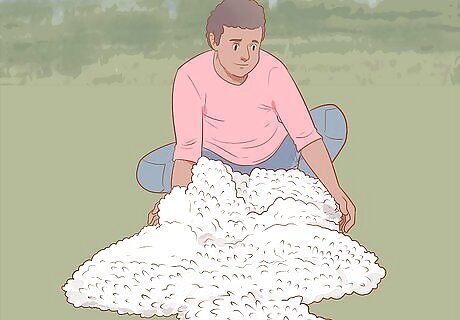
Skirt and roll the fleece. Once the sheep have been sheared, you will need to skirt and roll the fleece (if you plan on selling the wool). Skirting means removing any dirty or "incidental" wool which is not valuable and therefore not used for selling. To skirt the wool, place the fleece flesh-side down on a flat table or other surface. Spread it all out til it forms a single layer. Remove any dirty or contaminated wool from the outside edges of the fleece - this includes any off-color wool, tags, or matted wool. These bits are mostly found on the wool that was on the belly, legs, and rear end of the sheep. Once the contaminated wool has been removed, you can roll the fleece. The best way to do this is to fold the long sides of the fleece towards the center, then roll the fleece from one end to the other, so the flesh side is facing outwards. This creates a neat package that can be easily transported for sale. Do not tie the rolled fleece, as this can lessen the value of the wool.
Shearing Like a Pro
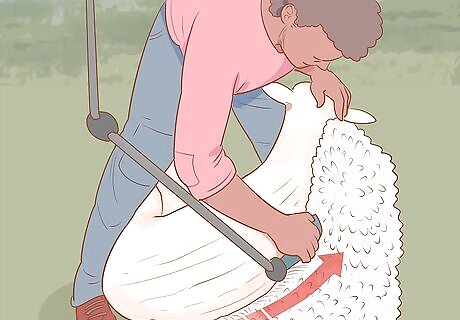
Make long, confident blows. One of the most important aspects of becoming a good shearer is to be confident with your blows. Try not to second guess yourself or fumble with the shears, this will only increase your chances of making a mistake. Try to develop a rhythm as you shear, this will help you to move easily from one section to another.
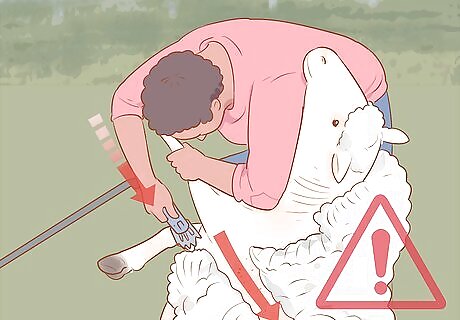
Avoid making second cuts. Sometimes when a blow is performed incorrectly, you will need to make a second pass with the shears to remove the remaining wool. The small bits of fleece that result from this second pass are known as second cuts. Second cuts are undesirable as they cannot be included in the rolled fleece. This is because they make yarn weaker and cause it to pill more easily. The more experience you have, the less likely you are to produce second cuts. Being confident with your blows will help you to avoid them.
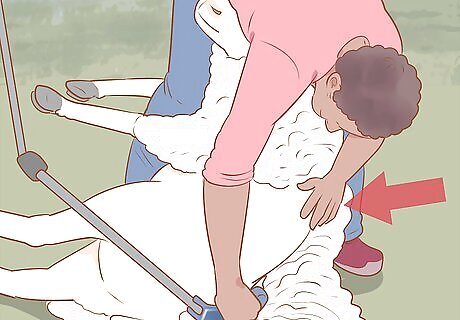
Use your left hand to keep the skin pulled taut. The shears will move more easily and get a closer cut when the sheep's skin is pulled taut. Therefore, it is important to constantly use your left (or non-dominant) hand to stretch the skin you are about to shear. This is particularly important for sheep with finer wool, as their skin is more wrinkled and harder to see through the excess wool.
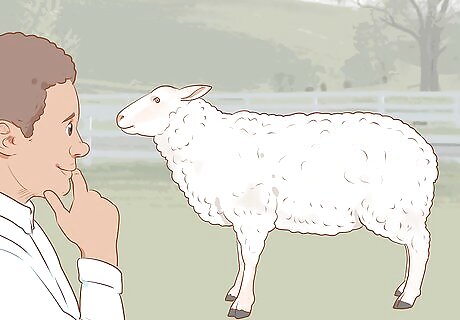
Know your sheep. Being familiar with your sheep will make a world of difference when it comes to shearing. Knowing whether she's fat or skinny will help you to navigate her body shape and move the shears at the right angle over her hips, shoulder, and spine. Knowing how many teats she has (some sheep have two, others have four) will help you to avoid them while shearing, and prevent you from accidentally shaving any off. Being familiar with the overall health of your sheep is also useful. Healthy sheep produce plenty of lanolin (a wax-like substance produced in the sebaceous glands) which melts and lubricates the clippers on the shears, helping the wool to come away more easily. The lanolin on unhealthy sheep tends to stay thick, clogging up the clippers.



















Comments
0 comment